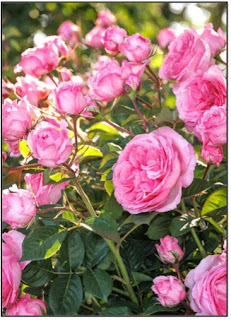 |
| Elderberry berries photo by Gary Houston, CC0, via Wikimedia Commons |
By Susan Belsinger
Elderberry Juice
By cooking down freshly harvested or frozen elderberries with just a little water, and allowing the contents to cool, the concentrated juice can be extracted from the berries and the juice will be ready to use in recipes, or frozen for a future use. This juice concentrate can be the base of many recipes from jams and jellies, shrubs, syrups, cordials, and much more. It must be refrigerated and used within 24 to 48 hours or frozen (for up to 6 months). Or process in a boiling hot water bath in canning jars: pints for 20 minutes and quarts for 30 minutes. Here is a recipe for extracting the juice using 6 cups of berries—it is easily multiplied or divided—depending on the quantity of berries you have. Makes about 2 cups of juice
Ingredients:
6 cups stemmed elderberries or 2 cups dried elderberries
1 cup water
In a non-reactive saucepan, combine the berries and water and place, cover and place over medium heat. Bring the berries and water to boil, stirring occasionally. Reduce heat and simmer for about 3 to 5 minutes. Remove from heat, set the lid askew and let cool to room temperature.
The berries and water will have cooked down to between 2 1/2 to 3 cups. Once cooled, strain the juice through a strainer lined with cheesecloth. Squeeze the contents gently to extract all of the essence. There should be about 2 cups; you can add a little water to equal 2 cups if need be for a recipe. Use in a recipe or process in canning jars in a boiling water bath immediately.
Elderberry Syrup
Prepare the juice above to make this syrup. It can be made in smaller or larger quantities. I do not make large quantities; if you do, it will need to be refrigerated (for up to two weeks) or it is best to process it in canning jars in a boiling water bath and it will keep for up to 1 year. This syrup has so many wonderful uses. I use it straight by the teaspoonful for the symptoms of cold, flu, cough. I use it as the base for cordials and shrubs. It makes a delicious natural soda with sparkling water, combines well in punches, cocktails, with tea or lemonade, as a syrup for pancakes and waffles, drizzle over cakes and fruit, as a base or topping for ice cream. Note: sometimes I prepare this with pure maple syrup, which is yummy; it will be thinner than syrup prepared with honey. Makes 1 quart of syrup
Ingredients:
2 cups elderberry juice
2 cups local honey
In a deep bowl, combine the juice and the honey with a whisk. Take your time to combine it so it doesn’t slosh out of the bowl. Pour the syrup into a jar, label, and store in refrigerator for two weeks or process in canning jars in a boiling water bath: half-pints for 10 minutes and pints for 15 minutes. Be sure that they have sealed; if not refrigerate and use within two weeks.
Elderberry Shrub with Honey
This recipe is excerpted from the creative herbal home, Susan Belsinger and Tina Marie Wilcox, herbspirit, 2007. We have been preparing elderberry shrub for years with only beneficial effects. Awhile back, we found out that elderberries should always be cooked before being eaten to avoid the possibility of ingesting unripe berries. Unripe berries contain prussic acid that causes cyanide poisoning if the berries are not cooked first before being consumed. http://www.herbalsafety.utep.edu/herbs-pdfs/blackelder.pdf. In the past, we made shrub without cooking the berries. We select only the ripe berries and carefully remove them from the stems before adding them to the vinegar. However, to be safe, we recommend that you bring your vinegar to a simmer and pour it over the elderberries, then proceed with the recipe.
Recipes for shrubs, also referred to as “switchel” and “beveridge” vary greatly and date as far back as pre-colonial times. Shrubs can be made with sweetened fruit juice, fruit, vinegar, honey or sugar. Some suggest adding spirits such as rum or brandy to the shrub. We have never used spirits to make our shrubs but find the idea seductive.
Generally shrubs are sipped from a cordial glass, poured over ice, or served with a bit of sparkling water. They are a wonderful remedy for congestion, sore throat, and an excellent tonic for the body. They tend to make us perspire when we drink them. Of course, we choose elderberries for this shrub, however, you may substitute other berries such as blueberries, raspberries, blackberries, currants, gooseberries, or a combination thereof. Makes about 2 quarts
Ingredients:
2 cups ripe elderberries
1 quart apple cider vinegar
1 quart honey
Wash and pick over the berries. Put the berries in a non-reactive pan. Pour the vinegar over the berries, cover and bring to a low simmer. Remove from heat and let stand until room temperature. Transfer the contents of the pan into a clean, canning jar and cap with a lid. Let stand two to four weeks; we shake our shrub daily.
Mash the fruit vinegar and strain through cheesecloth or muslin. Add the honey and blend well. Bottle in dark glass, sterilized jars with non-metal lids. Label contents in bottle; keep out of reach of children.
Store in a cool dark place. We have never known of shrub to go bad in storage however, it will do the body more good if it is used rather than stored. Use it within one year.
Source: Susan Belsinger ©2013 Elder, Herb of the Year 2013™
See more at: https://susanbelsinger.com/
and on the Elderberry episode of the GardenDC Podcast at: https://washingtongardener.blogspot.com/2024/02/gardendc-podcast-episode-183-elderberry.html
PIN THIS FOR LATER!
Elderberry marmalade image by saponifier, CC0, via Wikimedia Commons












